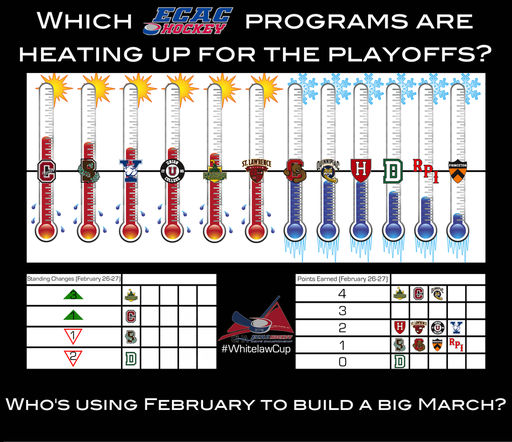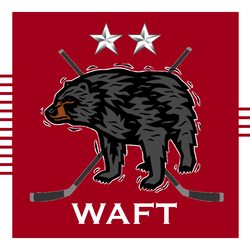Idleness is to the human mind like rust to iron.
Another season likely will have come and gone by the time this evening ends. Another champion will have lifted the prize that the skaters of Cornell University covet and view appropriately, at least from a historical lens, as their birthright. This time, it may even be a first-time winner. It would be the second of such an order of winner since the Red won its last Eastern title.
Back in this writer's day, a day that was not that long ago relative to the eras of others, Cornell made the final weekend of ECAC Hockey. It was as guaranteed as the fact that those last tickets in the most important arsenal of the Lynah Faithful would be used on the second weekend in March. Back in the day of most alumni, Cornell won this thing.
Cornell missed ECAC Hockey's championship weekend in consecutive years for the first time since Coach Schafer revitalized the program at his alma mater. Coach Schafer missed getting to championship weekend in 1999, 2004, 2007, and 2013. He rebounded respectively with a semifinal appearance, Whitelaw Cup, semifinal appearance, and semifinal appearance. Schafer's team missed the 2015 ECAC Hockey Quarterfinal. This season, it broke the Big Red's redemptive streak.
The greatest cause for alarm is experiential. Three complete graduating classes, the Classes of 2014, 2015, and 2016, never won the Whitelaw Cup. For most programs, this is normal. At Cornell, it should not be. Three-quarters of all players who draped themselves in carnelian and white during the coldest months of the year have claimed Eastern glory at least once during their careers in Central New York. This establishes a birthright among players in their recruiting pitch and a haughtiness among the Lynah Faithful that grates the less decorated programs of ECAC Hockey.
The Big Red averages winning another Whitelaw Cup approximately every three to four seasons since it won its first at Boston Garden on March 11, 1967. This writer should not need to remind you of the following. Next season, when the contributors of Where Angels Fear to Tread return to Lake Placid, hopefully with Cornell accompanying them, it will have been seven long years since a team from New York's land-grant university won the Whitelaw Cup; a time more than twice to which the Lynah Faithful are conditioned.
The alarm associated with a gap in experience grows all the louder. No player on last season's team, this season's team, or next season's team will have played in a title game for the Whitelaw Cup. Five years currently separates Cornell from its last appearance in that deciding chapter. Cornell has appeared in 21 of ECAC Hockey's 55 title games, 38.2%, but not one of those appearances has come in the last half-decade. Will this team know how to win when it returns next time?
Even Harvard that ended its own nine-year title drought last season had players who earned berths to the Eastern championship match during their freshman seasons. Next season, Cornell would enjoy no similar luxury if it makes. Oh, how it pains one of this writer's era to make that sentence conditional.
This is not a diatribe to be strewn among the refuse about the need for a coaching change. Cornell's playoff run this season was admirable and redeemed this program. Game two of the 2016 ECAC Hockey Quarterfinal will be one long-lived in the annals of Cornell hockey untainted by the team's lack of claiming ultimate glory in Lake Placid. Coaches Knisley, Scott, Syer, and Schafer knew which puts to press and which strategies to exploit. A five-game, three-win playoff run proves that.
The hunger is back. The juniors who will become seniors exhibit a need to win that few classes in recent memory have. Their class contributed 69.2% of Cornell's post-season goals. They are ready to roll up their sleeves. The last four years have taught the importance of having a healthy palate cleanser of a first-round bye.
Earning of that bye must be paramount again. In the rhetoric of this team, it has fallen too easily by the wayside. Such ambiguity in mission or season goals, something Casey Jones when an assistant coach at Cornell attested Coach Schafer always avoided, might explain the Big Red's bad January that required its playing in the first weekend of March.
The juniors may be ready to roll up their sleeves, but are they ready to sit at the table? Does the Red still have the manners to win? Cornellians are known for being too direct, especially among its Ivy brethren; a product of being the blue-collar Ivy, one assumes. Can a team of unseasoned players with not a game of title-game experience among them possibly end what will be tied as Cornell's second-longest Whitelaw-Cup drought next March?
Coach Schafer led a similarly "uncouth" group of Cornellians into the 1996 ECAC Hockey Final. They left with the Whitelaw Cup. Where did they do it? Lake Placid.
The Lynah Faithful are restless. Current students at Cornell University are gradually allowing a culture of low expectations to seep into their mindset. Winning games, not winning trophies, has become expected to them. That rust of low expectations needs to be shaken like the rust of the mind to which Cornell University's founder, Ezra Cornell, refers to in this piece's opening passage.
Maybe, just maybe, this writer is tired of coming to Lake Placid and not seeing his alma mater's team play.
I love this event, I love this conference, but when will Cornell return to its rightful place within both? It's been too long.
Has Cornell forgotten how to win this thing?
Cornell has been too idle during the big game of March's penultimate weekend for too many Marches. Will next season's team be able to stop this drought as the second-longest in Cornell history? It may need to. The Faithful grow as ravenous as do the current juniors. The seniors have made them have more faith in the greatness that can come. Winning needs to follow.




 RSS Feed
RSS Feed
